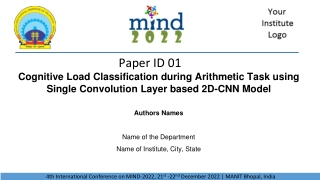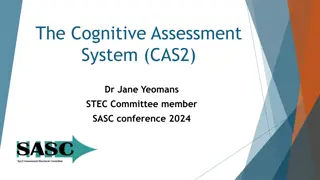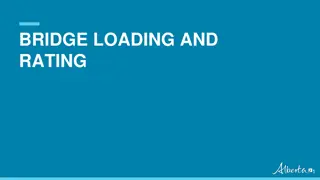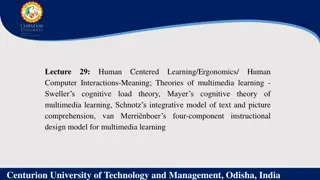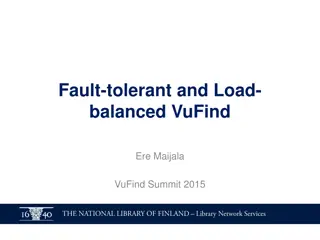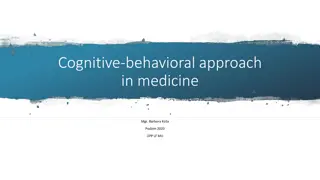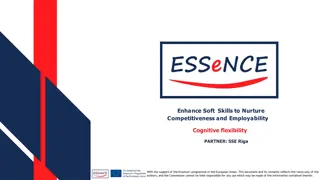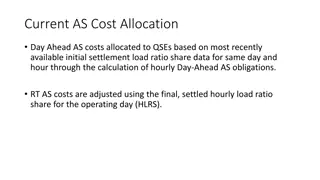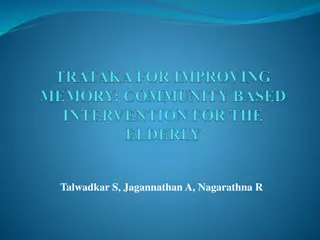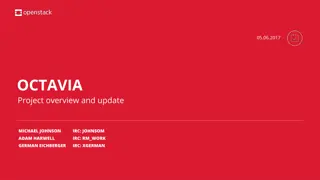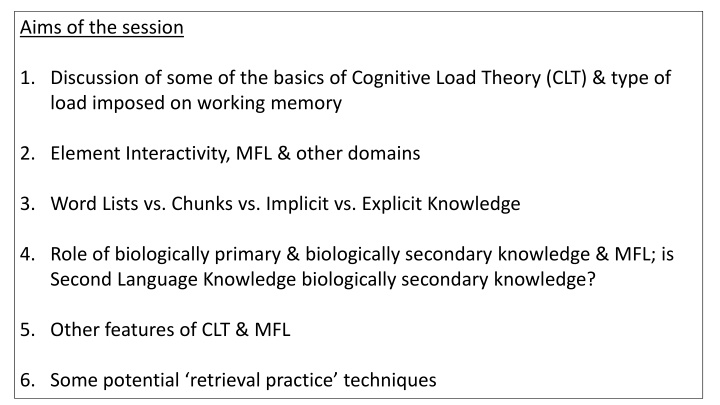
Basics of Cognitive Load Theory
Cognitive Load Theory (CLT) covers types of cognitive load imposed on working memory, element interactivity, word lists vs. chunks, explicit vs. implicit knowledge, role of primary and secondary knowledge, and more in MFL. The session discusses retrieval practice techniques and key features of CLT in language learning.
Download Presentation

Please find below an Image/Link to download the presentation.
The content on the website is provided AS IS for your information and personal use only. It may not be sold, licensed, or shared on other websites without obtaining consent from the author. If you encounter any issues during the download, it is possible that the publisher has removed the file from their server.
You are allowed to download the files provided on this website for personal or commercial use, subject to the condition that they are used lawfully. All files are the property of their respective owners.
The content on the website is provided AS IS for your information and personal use only. It may not be sold, licensed, or shared on other websites without obtaining consent from the author.
E N D
Presentation Transcript
Aims of the session 1. Discussion of some of the basics of Cognitive Load Theory (CLT) & type of load imposed on working memory 2. Element Interactivity, MFL & other domains 3. Word Lists vs. Chunks vs. Implicit vs. Explicit Knowledge 4. Role of biologically primary & biologically secondary knowledge & MFL; is Second Language Knowledge biologically secondary knowledge? 5. Other features of CLT & MFL 6. Some potential retrieval practice techniques
-Cognitive Load Theory (CLT): What is Cognitive Load? Total amount of mental activity imposed on working memory -Load can be classified into three different types -Types of Cognitive Load: Intrinsic Cognitive Load, Extraneous Cognitive Load & Germane Load -Intrinsic Cognitive Load: The inherent complexity of the material/information-it is to do with the intrinsic structure of the information 1 -Extraneous Cognitive Load: The way material/information is presented to the learner or the instructional design of the material -Germane Resources: Related to working memory resources which are dedicated towards information pertinent to learning -Level of extraneous & intrinsic load to defined by element interactivity -Elements can be described as schemas; schemas composed of sub-elements-before schema is developed the sub- elements must be co-ordinated as separate elements in working memory -When sub-elements assimilated into schema, schema considered single element in working memory
Element Interactivity across the curriculum -How many different knowledge elements need to be coordinated in working memory in order to process the symbol for gold ( Au )? -Chemical symbols can be processed independently from other symbols; they can be learned in isolation & are examples of low-element interactivity information -However, an equation like '2 HCl + 2 Na 2 NaCl + H2 is high in element interactivity -There are a number of different elements which must be processed at the same time in order to accomplish the equation -These elements relate to one another & so must be processed together
Element Interactivity & MFL -Item of vocabulary vs. sentence - le chat vs. le chat s'est assis sur le paillasson. -How many knowledge elements have to be coordinated in working memory in order to process le chat as a meaning? - Working Memory can only accommodate 4 items at any given time for only a handful of seconds. By learning 4 chunks made up of 4 words each instead of 4 single words, the brain is still processing 4 items but working with 16 words at the same time 2 -Word Lists vs. Chunks vs. Implicit vs. Explicit Knowledge - enabling EK to become IK is in actual fact the ultimate goal of language teaching.
1) 2) 3) 4) 5) 6) 7) vi una pel cula espl ndida = I saw a splendid film vimos una pel cula espl ndida = we saw a splendid film veo unas pel culas espl ndidas = I watch splendid films tienen que llevar un uniforme = they have to wear a uniform no tenemos que llevar un uniforme = we don t have to wear a uniform tuve un examen complicado = I had a complicated exam al d a siguiente voy a tener un examen m s f cil = on the following day I am going to have an easier exam (no) va a ser genial = it is (not) going to be great decid ir a un restaurante elegante = I decided to go to a posh restaurant 10) fui al polideportivo enorme que acaban de construir = I went to the huge sports centre that they have just built 11) voy a viajar y ir a Espa a = I am going to travel and I will go to Spain 12) Despu s de esto = after this 13) voy a pasar m s tiempo con mis amigos = I am going to spend more time with my friends from class 14) no obstante = none-the-less 15) tenemos que estudiar m s mientras que los alumnos en Espa a pueden relajarse = we have to study more while the students in Spain are able to relax more 16) puedo hacer m s cosas con mis amigos = I am able to do more things with my friends 17) me fascina navegar por la Red = surfing the net fascinates me 18) por ejemplo, ayer, descargu m sica y mand unos mensajes en Whatsapp = for example, yesterday, I downloaded music and I sent some messages on Whatsapp 19) de vez en cuando suelo usar mi m vil para navegar por la Red = from time to time I tend to use my mobile in order to surf the net 20) voy a buscar un trabajo en una oficina cuando sea mayor = I am going to look for an office job when I am older 21) me llevo bien con toda mi familia aparte de mi hermano porque me molesta = I get on well with all my family apart from my brother because he annoys me 1. 2. 3. 4. 5. 6. 7. 8. 9. 10. el tiempo hace mucho sol = the weather is very sunny 11. el tiempo hizo mucho calor = the weather was very hot 12. el tiempo hizo mucho sol = the weather was very sunny 13. llueve = it s raining 14. llovi = it rained 15. lo paso bien = I have a good time 16. lo pas bien = I had a good time 17. que = who/that/which/than 18. la semana pasada = last week 19. hace una semana = a week ago 20. el fin de semana pasado = last weekend 21. el fin de semana = at the weekend 22. actualmente = currently 23. hoy en d a = these days 24. el fin de semana que viene = next weekend 25. este fin de semana = this weekend 26. pronto = soon 27. me ayuda a relajarme = it helps me to relax 28. tiene = it has 29. tuvo = it had 30. ten a = it had (used to have) 31. siempre he querido ir a = I have always wanted to go to fue = it was OR it went fueron = they were OR they went hice = I did hizo = he/she/it did hago = I do hace = he/she/it does era = it was/it used to be eran = they were/used to be el tiempo hace mucho calor = the weather is very hot 8) 9)
Biologically Primary vs. Biologically Secondary Knowledge & MFL -Tension between immersion & second language learning re biologically primary & biologically secondary knowledge; contentious issue warning! - The suggestion that learning a second language should mimic the learning of a first language ignores much of what we know of human cognitive architecture and its consequences for instructional procedures. 3 -We have not evolved to acquire reading & writing as biologically primary knowledge -Sweller refers to biologically primary & biologically secondary knowledge; biologically primary knowledge is knowledge we have evolved to acquire & biologically secondary knowledge requires explicit instruction
Biologically Primary vs. Biologically Secondary Knowledge & MFL cont. -If we regard Second Language Acquisition as biologically secondary knowledge then according to Sweller it is because it follows some key features associated with other domains of biologically secondary knowledge; these being: -Information-store principle; in order to function competently in a domain we need to acquire a body of knowledge stored in long-term memory -Borrowing & reorganising principle; studying of knowledge produced by others through reading & listening work leads to learner reorganising that knowledge with knowledge previously stored in long-term memory -Randomness-as-genesis principle; the less secondary language knowledge available to a learner, the more a learner may resort to random generation of phrases & language -Narrow limits of change principle; the limited processing capacity of working memory can lead to a learner of a second language enduring an incredibly high working memory load -Environmental organising and linking principle; no limits (as far as is known) on transferring knowledge from long-term memory into working memory-caused by signals in environment, relevant information is transferred from long-term memory into working memory in order to deliver actions in Target Language
Biologically Primary vs. Biologically Secondary Knowledge & MFL cont. -If we regard Second Language Knowledge as biologically secondary knowledge or not basing instruction around managing learners cognitive load seems eminently sensible -Sweller discusses how learners of secondary languages should be explicitly taught that language & not be exposed to it in a manner which would mean they have to induce meaning -Reducing potential for split-attention effects; if two sources of information which cannot be understood on their own are significantly & spatially separated then this may lead to extraneous cognitive load; Sweller refers to vocabulary/translations & their meanings -The redundancy effect; if & when translation is known then that meaning is no longer required leading to redundant processing of information (extraneous load) -The expertise-reversal effect; as more knowledge is acquired & learners no longer need a translation then getting rid of the translation meaning, for example, may avoid unnecessary processing for when the learners have developed a relative level of expertise - with increasing expertise, immersion is likely to become increasingly effective.. 4
Retrieval Practice In Learning as a Generative Activity: Eight Learning Strategies That Promote Understanding, the authors, Logan Fiorella & Richard E. Mayer, define generative learning as, helping learners to actively make sense of material so they can build meaningful learning outcomes that allow them to transfer what they have learned to solving new problems. 5 One of the strategies described to foster this benefit of generative learning is self-testing. As regards to boundary conditions for self-testing, Fiorella & Mayer say, free-recall, cued-recall, or otherwise open-response practice tests appear to be more effective than practice tests, such as a multiple-choice test. 6 recognition According to the authors the reason for this could be because of a generation effect that occurs when a learner is forced to generate an answer being more powerful than the effect generated by the learner having to only recognise the correct answer from a choice. Free Recall Tests ( Output Tasks or Brain Dumps )-students have 10-15 minutes to complete a Free Recall Test in books on a blank page on formation of a tense. Taking in books following the Free Recall tests allows me to identify misconceptions in students understanding of a tense. Have the students Made sense of the tense ? Another reason for adopting Free Recall tests is to move away from gapfills in class with the students. Grammar teaching is currently taught in many classrooms through teacher led explanations followed by gap-fills. This does not lead to automatization & fluency. 18 (Gianfranco Conti) Cuando estoy de vacaciones mi familia y yo Can students execute tasks without the need to refer to the text book or a learning mat? Does this activity help to promote automaticity?
To The Walls Instructions Explain to the class that they are going to work in groups of three on the MWBs to conjugate verbs. The students get into their groups, stand by an MWB and assign the roles of scribe, checker and tense endings boss (roles as described above). Give the scribe in each group a marker pen. Call out a Target Language infinitive from the list on the board. Each group works together to write the whole paradigm/verb pattern (or a term that the students are familiar with) of the infinitive together with the English. Model an example yourself on a group s MWB. The group to write the whole paradigm first wins a point. You will then call out another infinitive, and so on, until one group has scored five points. Variations to the FLA Only project the list of infinitives to see if students can recall how to write whole paradigms without any support. Instead of verb endings get students to do the Verbal Volley (VFLA #8) on the MWBs. Project a list of vocabulary and have one student writing and speaking a Target language word and English meaning, followed by the other student doing the same with the next word down the list and so on. Students swap their roles after every infinitive, so that the scribe gets to be the checker and so on. Run the FLA with pairs at each MWB. Give each student a marker pen. Student A can only write Target Language and B can only write the English for it. Use To The Walls for practising several tenses. Have the formation of three, four, five different tenses projected on the board with a set of regular infinitives. Call out the infinitive followed by the tense you want the students to conjugate. For example, Put comer in the present tense! If the students know the Target Language for the names of the different tenses then use that.
References 1John Sweller, Paul Ayres and Slava Kalyuga, Cognitive Load Theory (Explorations in the Learning Sciences, Instructional Systems and Performance Technologies), Kindle edn (New York: Springer, 2011), loc. 934. 2 Gianfranco Conti, Patterns First Why You Should Ditch Word Lists, Traditional Grammar Rules and Your Textbook , The Language Gym [blog] (21 May 2017). Available at: https://gianfrancoconti.wordpress.com/2017/05/21/why-you-should-ditch-word-lists-and-traditional- grammar-rules/. 3 See http://contact.teslontario.org/cognitive-load-theory-esl/. 4 Idem. 5 Logan Fiorella & Richard E. Mayer, (2015) Learning as a Generative Activity Eight Learning Strategies That Promote Understanding, New York, Cambridge University Press. p. vii. 6 Logan Fiorella & Richard E. Mayer, (2015), p. 119.

